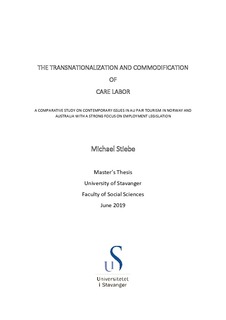| dc.contributor.advisor | Osmundsen, Dag | |
| dc.contributor.author | Stiebe, Michael | |
| dc.coverage.spatial | Norway and Australia | nb_NO |
| dc.date.accessioned | 2019-10-11T11:46:21Z | |
| dc.date.available | 2019-10-11T11:46:21Z | |
| dc.date.issued | 2019-06 | |
| dc.identifier.uri | http://hdl.handle.net/11250/2621619 | |
| dc.description | Master's thesis in International Hospitality Management | nb_NO |
| dc.description.abstract | Au Pair tourism is an increasingly popular activity in many places around the world. Au Pair tourism has its roots in Switzerland in the mid-19th century and has ever since developed from a formerly upper-class cultural exchange phenomenon to one that now spans a broader socio-economic spectrum regarding both, host families and Au Pairs. Europe has tried to formalize Au Pair employment via a supranational European Agreement on Au Pair Placement in 1969. A handful of countries, among them Norway, have ratified and adopted this agreement and their Au Pair schemes build upon this more than four decades old legal framework. Norway’s Au Pair market is thus highly formalized and regulated yet does not consider Au Pairs as workers which causes controversy and high rates of foreign workforce exploitation. Previous scholarship on this issue claims that Norway is part of a global care chain meaning the Global North exploiting the Global South. Australia, a prime Au Pair destination, has a largely unregulated Au Pair market and does not have a dedicated Au Pair scheme. In Australia exploitative working conditions for young migratory care workers seem to be the rule rather than the exception. This study investigates the advantages and disadvantages of unregulated and regulated Au Pair markets using the two cases Australia and Norway. The study was preceded by a pre-study which was conducted in the second half of 2018 in Australia. A total of 16 semi-structured interviews with researchers, organizations, and Au Pairs in Australia and Norway have been conducted and build the foundation for any conclusions in this paper. This paper also contains a model that allows to estimate the nature of the relation between certain sending and host countries, called ECDI (Econo-Cultural Distance Index). Lastly, suggestions for improvement to both the Australian and the Norwegian Au Pair employment regulations. | nb_NO |
| dc.language.iso | eng | nb_NO |
| dc.publisher | University of Stavanger, Norway | nb_NO |
| dc.relation.ispartofseries | Masteroppgave/UIS-SV-NHS/2019; | |
| dc.subject | hotelladministrasjon | nb_NO |
| dc.subject | reiselivsadministrasjon | nb_NO |
| dc.subject | Australia | nb_NO |
| dc.subject | Norway | nb_NO |
| dc.subject | au pair | nb_NO |
| dc.subject | temporary labor migration | nb_NO |
| dc.subject | conflicting definitions | nb_NO |
| dc.subject | workers rights | nb_NO |
| dc.subject | domestic labor | nb_NO |
| dc.subject | childcare crisis | nb_NO |
| dc.subject | cultural exchange | nb_NO |
| dc.subject | global care chain | nb_NO |
| dc.title | The Transnationalization and Commodification of Care Labor: A Comparative Study on Contemporary Issues in Au Pair Tourism in Norway and Australia with a Strong Focus on Employment Legislation | nb_NO |
| dc.type | Master thesis | nb_NO |
| dc.description.version | submittedVersion | nb_NO |
| dc.subject.nsi | VDP::Social science: 200::Economics: 210::Business: 213 | nb_NO |
